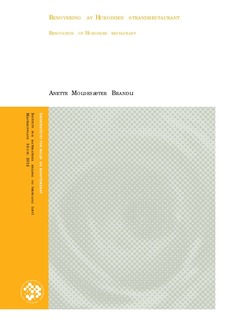| dc.description.abstract | Sammendrag
Renovering av Hukodden strandrestaurant på Bygdøy har vært hovedmålet med denne
oppgaven. Hukodden strandrestaurant ble opprinnelig bygget som et badehus tilknyttet Villa
Grande under andre verdenskrig. På 1950-tallet ble bygget omgjort til strandrestaurant og har
fungert som dette siden. Restauranten fikk en mindre oppgradering i 2004 da restauranten ble
overtatt av Sultgruppen, og er i dag en sommerrestaurant med åpningstider fra mai til medio
september. Restauranten er bygget i en blanding av nasjonalromantisk og modernistisk stil og
står på Riksantikvarens gule liste over bevaringsverdige bygg. Målet med oppgaven har vært
å prosjektere en brukervennlig helårsrestaurant med utvidet kapasitet, skape en tilknytning til
Holocaustsenteret i Villa Grande, samtidig som bygget beholder sine fasader og uttrykk.
Ulike metoder har blitt benyttet for å løse oppgaven. Prosjekteringsverktøyene SketchUp Pro
og ArchiCAD 15 er blitt benyttet til formstudie og tegning av bygget. Energiberegninger er
uført i energiberegningsprogrammet SIMIEN, hvor det har blitt utført beregninger både før og
etter renovering. AutoCAD Civil 3D har blitt benyttet for terrengbehandling og analyse og
3Ds Max har blitt benyttet for visualisering av bygget i sammenheng med terrenget. Gjennom
et litteraturstudium har det blitt sett på historien til strandrestauranten, hvilke tiltak som må
gjennomføres ved oppgradering til en helårsrestaurant, materialvalg for et bygg i så nær
tilknytning til sjøen og hvilken fornybar energikilde som er mest gunstig.
Resultatene viser at det er fullt mulig å utvide restauranten og oppgradere til en
helårsrestaurant ved hjelp av gode løsninger. Kapasiteten har blitt utvidet, bygget har blitt
universelt utformet og eksisterende bygningsmasse har blitt etterisolert. Energiberegninger
viser at ved hjelp av etterisolering har bygget gått fra et antatt totalt netto energibehov på
223,2 kW/m
2
til 150,7 kW/m
2
pr. år. CO2 – utslippet pr. år har også blitt redusert fra 89,6
kg/m
2
til 41,8 kg/m
2
.
Konklusjonen er at i dette tilfellet er det fullt mulig å utvide et bevaringsverdig bygg og
etterisolere slik at bygget kan brukes hele året, samtidig som bygget beholder sine fasader. I
tillegg er tilknytningen til Holocaustsenteret i form av utstillingslokale og betongklosser
opprettet. Abstract
The renovation of Hukodden beach restaurant at Bygdøy has been the main goal in this
exercise. Hukodden beach restaurant was originally built as a beach house in conjunction with
Villa Grande during the Second World War. In the 1950’s it was converted into a beach
restaurant which it has functioned as since. The restaurant got a minor upgrade in 2004 when
the running of the restaurant was taken over by Sultgruppen. Today the restaurant is open
from Mai to the middle of September. It is built in a blend of national romantic and
modernistic style and it holds a place on The Directorate for Cultural Heritage yellow list of
preserved buildings. The goal of this exercise has been to construct a user-friendly all year
restaurant with expanded capacity, and in doing so, also creating a link to the Holocaust
center at Villa Grande whilst the building maintains its facades and expression.
Different methods have been used to complete this exercise. CAD based tools as SketchUp
Pro and ArchiCAD 15 have been used to create initial drafts and the final design of the
building. Energy calculations have been performed with SIMIEN, where calculations have
been simulated both for the existing building and the proposed design. AutoCAD Civil 3D
has been used for the site works and terrain analysis. 3Ds Max has been used for visualization
of the proposed design in correlation with the site around it. Through a literature study several
key elements have been explored. The history of the building has been examined, what
measures must be taken to transform it into a whole year restaurant, what materials will be
best suited for a construction this close to the sea and finally an analysis of which renewable
energy source would yield the best results.
The results show that it is fully doable to expand the restaurant and allow it all year use with
the implementation of good solutions. The capacity has been expanded, the building has been
given universal access and existing constructions have been reinsulated. Energy calculations
shows that by re-insulating, the building has gone from a total net energy consumption of 223,
2 kW/m
2
to 150,7 kW/m
2
per year. CO2 – emissions has also been reduced from 89,6 kg/m
2
to
41,8 kg/m
2
per year.
In conclusion the results show that it is possible to expand a preserved building and reinsulate so that it can be used throughout the seasons, whilst allowing for the facades to be kept intact. In addition a link to the Holocaust center has been created by the concrete blocks
inspired by the Holocaust memorial in Berlin. The new construction will also have the
capacity to show exhibits from this era | no_NO |
